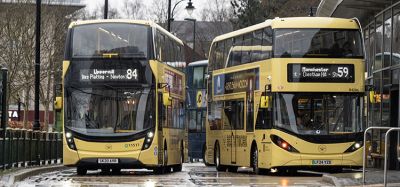Introduction of GNSS technology
- Like
- Digg
- Del
- Tumblr
- VKontakte
- Buffer
- Love This
- Odnoklassniki
- Meneame
- Blogger
- Amazon
- Yahoo Mail
- Gmail
- AOL
- Newsvine
- HackerNews
- Evernote
- MySpace
- Mail.ru
- Viadeo
- Line
- Comments
- Yummly
- SMS
- Viber
- Telegram
- Subscribe
- Skype
- Facebook Messenger
- Kakao
- LiveJournal
- Yammer
- Edgar
- Fintel
- Mix
- Instapaper
- Copy Link
Posted: 17 February 2007 | Mr. Philippe Monier and Mr. Bernard Lamy, Thales Transportation Systems, France | No comments yet
Unlike 5.8 GHz based tolling systems, which rely on a stable and standardised technology, GNSS systems have many possible implementations although all based on the use of satellite localisation. The pioneering initiative of Toll Collect in Germany proved the feasibility of this technology for tolling but the European community now has to address the many challenges in the field of system architecture, standardisation, and technical and operational interoperability.
This article presents an overview of these challenges and the possible answers and decisions from all market stakeholders to transform these challenges into market opportunities.
Unlike 5.8 GHz based tolling systems, which rely on a stable and standardised technology, GNSS systems have many possible implementations although all based on the use of satellite localisation. The pioneering initiative of Toll Collect in Germany proved the feasibility of this technology for tolling but the European community now has to address the many challenges in the field of system architecture, standardisation, and technical and operational interoperability. This article presents an overview of these challenges and the possible answers and decisions from all market stakeholders to transform these challenges into market opportunities.
Unlike 5.8 GHz based tolling systems, which rely on a stable and standardised technology, GNSS systems have many possible implementations although all based on the use of satellite localisation. The pioneering initiative of Toll Collect in Germany proved the feasibility of this technology for tolling but the European community now has to address the many challenges in the field of system architecture, standardisation, and technical and operational interoperability.
This article presents an overview of these challenges and the possible answers and decisions from all market stakeholders to transform these challenges into market opportunities.
The article is structured around the ten most frequently asked questions that cover the entire scope of the problem and have been raised frequently by all stakeholders of (Electronic Fee Collection) EFC in Europe, be it the industry, the end users or operators.
GNSS: QUESTIONS AND ANSWERS
Is there a need for introducing GNSS for tolling in Europe?
A common opinion in southern European countries, which have a well-established ‘traditional’ toll infrastructure, is that the existing DSRC systems might be sufficient as a tolling means for the future. This was strongly debated at the time of the introduction of the EU Directive on EFC.
The fact is that DSRC is perfectly suited for use as an efficient payment means on main motorways, in toll plazas or even in free-flow. However, there is a growing need for charging for the use of other classes of road infrastructures, both for funding new infrastructure and for other reasons such as environmental or maintenance costs generated from circulation of heavy vehicles. For very dense networks made of ‘secondary’ roads, DSRC is not economically effective, since its large-scale implementation on a wide network would require a huge investment in deployment. Even if the cost of charging point equipment reduces in the future, the cost of civil works engineering, including mains supply and telecommunication connections, would not be reasonable for a large road network, not to mention maintenance costs.
Another area is the congestion charging application. So far, DSRC or Video Tolling has been used but they can only serve zone charging and not mileage charging. Since the systems aim at reducing the traffic, it fits the requirement better if the is charge levied according to the distance travelled inside the tolled area. Here again, GNSS is a solution.
For such situations, GNSS has the considerable advantage of relying on existing telecom infrastructures and nothing else except enforcement components. This unique feature, and the need for levying tolls for a larger class of roads, makes the future use of GNSS in Europe a certainty. Whether GNSS will replace DSRC or not is another question.
Is DSRC an old technology to be phased out and replaced by GNSS?
Some EFC market stakeholders believe so, promoting the idea that DSRC is an ‘old’ technology which has no significant future when GNSS is introduced. This is probably not true, for several reasons:
- At the moment, the DSRC on board unit (OBU) features a very significant cost advantage compared to GNSS (a tenfold span), which will decrease over time but can only become negligible when GNSS OBUs come as factory mounted OEM devices in vehicles, which will not happen for several years, especially if there is no legal standardisation in Europe at least
- Apart from inter-urban taxation and tolling, Europe offers a very significant market for congestion charging systems that addresses light vehicles and, as such, requires a very low cost OBU which only DSRC can offer today
- There are large existing systems using DSRC (Austria, France, Italy, Portugal, Spain), and this investment can only be phased out gradually. These existing OBUs are also a huge enabler for easing the introduction of congestion charging in large cities – interoperable and possibly interoperated with inter-urban tolling
- DSRC will probably be used as an enforcement means for GNSS systems, which will contribute to extending the life of DSRC and favour DSRC / GNSS interoperability.
Even if, as some experts point out, there is a mid-term risk of replacement of DSRC by other technologies, such as radio frequency identification (RFID), most of the above remains true. A low-cost OBU, short distance communication technology will remain necessary for the EFC market for the next eight to 10 years.
Will light vehicles be a market trigger or a market stopper for GNSS?
The answer to this question is uncertain and represents a chicken-and-egg situation: the acceptable OBU cost for a light vehicle probably lies in the range of €30 including installation cost, and this can only be achieved with OEM devices and not retrofit equipment, since the installation alone costs more than €30. Furthermore, unless there is a regulation forcing the car industry to embed GNSS equipment for tolling in every car (which is extremely unlikely and will not apply for existing vehicles), car manufacturers will not invest in such a device if it cannot bring other added value applications on board. Moreover, most of these applications can only exist from a business model point of view if they can avoid the cost of a retrofit unit!
There are valuable technical initiatives taking place today, such as CALM and GST to cite the most prominent, which aim at enabling a multi-media multi-application vehicle. This however only helps solve the technical issues, not the business case. It is reasonable to think that the business case might be simplified by the existence of the EETS service (pan European tolling) if it is sufficiently well defined, standardised and cost efficient. This would encourage low cost compatible and certifiable industry solutions, which will be transferred later into light vehicles OEM OBUs.
This desirable situation requires an interoperable EETS service (i.e. a non-fragmented market in terms of technical solutions) to offer a sufficient market size and sufficient harmonisation of solutions.
What are the possible architectures for EETS GNSS and their advantages?
There are indeed a number of possible system architectures that have been accurately identified by the RCI project, but can be split into two main groups globally:
- The so-called ‘thick client’ architecture, in which the OBU has an application-processing capacity, an MMI, contains maps and builds toll / tax transactions on its own
- The ‘thin client’ approach, that relies on a simple OBU, mostly gathering satellite positions and transferring these to a central system. This can also be considered as a centralised architecture in comparison to the ‘thick client’.
At first glance, the thick client appears better, especially in terms of further capacities for ITS applications. However, it seems that the thin client architecture, which in essence is of the same kind as the digital tachograph except that it operates wirelessly through telecom networks, and is better suited to the current constraints of EETS. A full comparison exceeds the scope of this article, but the most important points are the following:
- The centralised thin client architecture offers the best possible flexibility regarding tariff rules, geographic delimitation of toll zones, map matching rules and reference maps. All this is obviously key to easy interoperability for national systems
- This architecture requires only minimal features from the OBU, easing the introduction of low cost units, and most importantly, offering migration to interoperability with no alteration whatsoever of the OBUs
- It does not require complex downloading infrastructure and content management which are not only complicated entities, but have no obvious justification in operators’ business models
- It enables the quick establishment of a certification environment.
Simply put, thin client architecture fits today’s constraints and it is future-proof.
Is building GNSS EETS interoperability an easy task, or is it impossible?
The first issue that is key to the success of EETS is its quick introduction. This raises several challenges, as despite the intense efforts of all tolling community members and of the European Commission to speed up the definition of EETS, the need for infrastructure funding is so urgent that the emergence of national systems, before EETS is fully introduced as a service, is unavoidable.
A situation in which these national systems would make complete use of proprietary and incompatible solutions would undoubtedly endanger the very existence of EETS.
In addition, one of the strongest reasons for making use of the thin client architecture is that it’s the only one that can be standardised fast enough to ensure that the main system interfaces of the various implementations remain compatible. Even if migration adjustments are needed, when national systems migrate to EETS, alterations will be confined to central systems where the migration cost can be handled.
From a business case point of view, operators must also find some economical efficiency in EETS: since the interoperated traffic is likely to be much lower than the national traffic for most countries, the additional cost of building the EETS system must be in proportion. We would go so far to say that the thin client architecture is the absolute optimum in this regard, for the above reasons.
Is thin / thick a ‘permanent choice’?
Of course not! This is a common misunderstanding, but what must be remembered is that TCA is an architecture and not equipment definition.
The thin client OBU functions and features may well be hosted or executed by a very ‘thick’ or intelligent on-board unit in the future, and will indeed be supported by the complete range of OBUs which will exist, according to vehicle class and type, user profile and so on.
The idea that one can rely on one OBU forever is a mere illusion from an industrial and operational viewpoint. This also means that a complex OBU may support a number of applications, and can be certified for EETS independently of the rest of its functional capacities. As a consequence, EETS must be perceived as a market enabler and the best possible way for promoting the progressive emergence of more complex OBUs serving the needs of a growing range of applications.
It must be noted that TCA is also the best way to avoid multiplication of on-board devices when several national systems start operating which is a real nuisance for users, especially freight companies.
How about non-tolling ITS applications?
In view of the above, the introduction of ITS applications to supplement tolling may seem easy. Again, there are two issues here: technical and operational. The technical issues to be solved mostly concern the independency of applications, in terms of software robustness, security and reliability. For example, the toll operator would not favour a dynamic guidance application that disturbs the accuracy of tolling, and if e-safety is offered by the OBU, its availability must not be threatened by the tolling functions. Of course, there are suitable technical solutions to this. The main problem is about certification for a range of applications, especially if complex OBUs are ‘updated’ over time.
From an operational point of view, it must be admitted that the introduction of ITS applications for light vehicles in the past has not been successful because of poorly designed business models and a lack of interest from the end users. EETS will not bring about a change by magic in this field but if it is properly standardised from the beginning and based on low cost OBUs, it will favour an industry trend to offer standard vehicle communication platforms. This is a necessary condition to its further adoption by the vehicle industry as OEM platform, as promoted by the CALM and GST concepts.
Another strong issue with a mix of added-value telematics applications and taxation/tolling applications is the fact that the Road User Charging is managed by a legal entity or a concessionaire and that such a legal entity has no right to sell something, especially if it is mandatory by law to have an OBU. This would then be considered as a huge distortion of the market.
DSRC and GNSS coexistence and migration
The current recommendation from the European Commission is to embed DSRC modules into the future EETS OBUs. This is technically easy and necessary for offering enforcement and although it has a direct cost impact, it is probably acceptable for operators and toll chargers. But that’s only the tip of the iceberg – the real question is the service definition of EETS, if it must encompass both existing interurban tolled motorways operated in DSRC closed-tolling by motorway operators and different networks, charged by the kilometre, operated by public authorities, or private ventures.
Such a coupling of toll and taxation raises complex financial, social and political issues, which cannot be solved in a day, although local subsidiaries will of course be the test bed for the first implementations.
As a consequence, there will not be a ‘D-Day’ introduction of EETS, but probably a progressive emergence of bilateral agreements between neighbouring countries that will, in the longer-term, merge into larger aggregates and finally into EETS, just as is the case today with DSRC. On the technical side, this obviously requires a high degree of flexibility regarding tariff rules, geo-elements definition, enforcement, and so on, and is best offered by a centralised architecture as pointed above. The major interfaces – OBU to infrastructure and toll ‘gateway’ to toll charger billing system – will remain constant throughout the process.
There are many players but who really drives the market?
The European landscape can be perceived as complex and intricate compared to the rest of the world. Here is an insight into the interests and actions of the domain’s main stakeholders:
The European Commission
Since the early 1990s, the Commission has promoted and funded wireless tolling technologies and the associated concept of EETS. The move to GNSS is more recent and is closely linked to the introduction of the Galileo system, which is another important European initiative.
The Commission’s approach is intense and judged by some market players as too ‘pushy’ (meaning too fast and authoritative). However, the heated debates that are ongoing about EETS prove that there is a strong interest from the whole community in this market. EETS is judged by some as a long-term goal that may never be achieved, but the action of the Commission is a catalyst and is probably the most efficient tool in avoiding total market fragmentation. This requires, however, that open questions and crucial technical choices are carefully studied and this can be done through EU-funded research projects, such as RCI and GST.
The industry
European industry is very active at creating technology solutions and building a suitable standardisation framework. The size of the market and existence of national projects ensure that a very strong competitive environment is maintained. The picture today regarding who will be the leading player is quite uncertain, as too many industry stakeholders are focused on finding a place in the market. In such a situation, there is a risk of fragmentation of the market into national ‘islands’, because a local industrial leader will promote its own solution in its own country.
The only remedy is to ease EETS creation by standardising the most important parts of the system and equipment as fast as possible so that these ‘islands’ can feature further compatibility. This is not in contradiction with industry interest because if this work is not carried out, the OBU cost barrier will be very difficult to break. A fragmented market means proprietary implementations hence limited quantities for a given solution and subsequently a high equipment price.
The operators and toll chargers
No organisation other than the operators and toll chargers can really build the EETS service. Compared to the past, a number of operators are taking a much more active part in the definition of EETS and their business intentions have also evolved. Even if some question the existence of EETS, most of their business intentions rely on a reduced scale version of the EETS and ITS model.
Obviously, such a situation is prone to power struggles. Only the European Commission can be the regulator and there have been significant efforts to establish communication structures for the different players through the Road Platform, the EFC Steering Committee and research projects. This framework is not perfect, but without it the market would probably never achieve its full potential. Please bear in mind that the fragmented and limited business of the wireless phone in the early 1980s became the top technology activity in Europe when the GSM was promoted by European organisations.
Standardisation, lessons learnt from DSRC and how to move forward
DSRC standardisation in Europe was technically sound, but was ridiculously long. If the same situation repeats itself for EETS, the GNSS market existence is threatened and operators will lean towards the ‘safe’ technology, i.e. DSRC. A fast standardisation of the main system interfaces that are critical to interoperability must be achieved and an equipment certification framework built accordingly.
In this regard TCA by its simplicity, allows for the fastest possible approach and does not require building complex reference environments. When the results of the RCI projects are available, two major points will be achieved: identification of the pitfalls for each architecture and the industry input for further standards. As a follow-up, the work started with the MISTER document will be finalised and feed the creation of the certification process and associated standards. The ongoing work for certification of DSRC equipment carried out by ETSI is a good base.
CONCLUSIONS
GNSS tolling is a very complex subject, and the above is just an overview. The main conclusions to note are the following:
- Electronic fee and tax collection is called the ‘killer application’ by the European Commission, in the sense that it will drive the full market of EETS and ITS. It might not be entirely true from an economical point of view, as the business drivers are not necessarily the same in both cases, but it is true that EFC is really the industry driver today and that industry solutions for EFC, if not directly, will enable other markets
- The thin client architecture is the most reasonable approach to help master today’s interoperability uncertainties, enable low cost on-board equipment and facilitate the establishment of a suitable certification environment
- Thin client architecture and equipment may be embedded into future complex solutions and enable a graceful migration to a broader ITS market, as well as the existence of a full range of on-board equipment
- The RCI project is one interesting focus point. Its results will definitely influence the future decisions regarding EETS and introduction of GNSS tolling in Europe
- It must be noted that in addition to the tolling system issues presented in this article, very significant work remains with regards to enforcement from a legal and operational viewpoint as a building block for interoperable GNSS systems.
Related topics
Ticketing & Payments
Issue
Issue 1 2007








